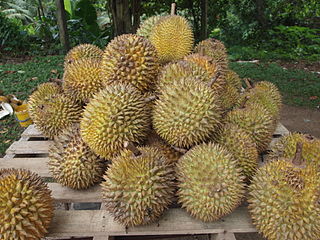
Bombacaceae were long recognised as a family of flowering plants or Angiospermae. The family name was based on the type genus Bombax. As is true for many botanical names, circumscription and status of the taxon has varied with taxonomic point of view, and currently the preference is to transfer most of the erstwhile family Bombacaceae to the subfamily Bombacoideae within the family Malvaceae in the order Malvales. The rest of the family were transferred to other taxa, notably the new family Durionaceae. Irrespective of current taxonomic status, many of the species originally included in the Bombacaceae are of considerable ecological, historical, horticultural, and economic importance, such as balsa, kapok, baobab and durian.

Durio kutejensis, commonly known as durian pulu, durian merah, nyekak, Pakan, Kuluk, or lai, is a primary rainforest substorey fruit tree from Borneo.

Durio zibethinus is the most common tree species in the genus Durio that are known as durian and have edible fruit also known as durian.

Durio dulcis, known as durian marangang, red durian, tutong, or lahung, is a fairly large tree in the genus Durio. It can grow up to 40 m tall. The husk of its fruit is dark red to brown-red, and covered with slender 15–20 mm long spines. The fruit flesh is dark yellow, thin, and deep caramel-flavored, with a turpentine odor. The fruit of this species is considered by many to be the sweetest of all durians.

Durio grandiflorus, commonly known as durian munjit, is endemic to the island of Borneo.

The black hornbill is a species of bird of the hornbill family Bucerotidae. It lives in Asia in Brunei Darussalam, Indonesia, Malaysia, Singapore, Thailand.
Durio acutifolius is a species of durian tree in the family Malvaceae. It is endemic to Borneo. The specific epithet, acutifolius, meaning "thorny leaves", is derived from Latin acutus, and -folius (-leaved).
Durio testudinarius, commonly known as durian kura kura is a species of durian tree in the family Malvaceae. It is endemic to Borneo.
Durio wyatt-smithii is a species of flowering plant in the family Malvaceae. It is a tree endemic to Peninsular Malaysia.

Prevost's squirrel or Asian tri-colored squirrel is a colourful species of rodent in the family Sciuridae. It is found in forests in the Thai-Malay Peninsula, Sumatra, Borneo and nearby smaller islands, with an introduced population in northern Sulawesi. Although the Prevost's squirrel is declining in some regions because of habitat loss and hunting, the species is not considered threatened since it generally remains common and widespread. It can live in somewhat disturbed habitats and often visits plantations or gardens. It mostly feeds on plant material, especially fruits, but also takes insects.
Fusarium gibbosum is a fungal plant pathogen.

The durian is the edible fruit of several tree species belonging to the genus Durio. There are 30 recognized Durio species, at least nine of which produce edible fruit. Durio zibethinus, native to Borneo and Sumatra, is the only species available on the international market. It has over 300 named varieties in Thailand and 100 in Malaysia as of 1987. Other species are sold in their local regions.

Daphnusa ocellaris, the durian hawkmoth, is a species of moth of the family Sphingidae.

Durian Burung is a small border town in Mukim Batang Tunggang Kiri, Padang Terap District, Kedah, Malaysia. Across the border is Ban Prakop of Songkhla, Thailand.

Durio graveolens, sometimes called the red-fleshed durian, orange-fleshed durian, or yellow durian, is a species of tree in the family Malvaceae. It is one of six species of durian named by Italian naturalist Odoardo Beccari. The specific epithet graveolens is due to the odor. Although most species of Durio have a strong scent, the red-fleshed type of D. graveolens has a mild scent. It is native to Southeast Asia.

Durio lanceolatus is a tree in the family Malvaceae. It grows up to 55 metres (180 ft) tall.

Durio oxleyanus is a perennial plant species of tree in the family Malvaceae. It was once placed in the family Bombacaceae.















